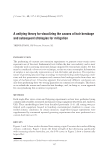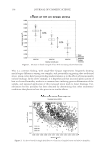SIRT6 KNOCKDOWN 31 DISCUSSION The physical interaction between SIRT6 and the NF-κB subunit, RelA, is required for the deacetylation of histones associated with NF-κB target gene promoters. Loss of suppres- sion of this proinfl ammatory pathway results in a shortened lifespan for the mouse (17). The increase in NF-κB levels we measured are in agreement with this fi nding as well as data reported for human fi broblasts transfected with SIRT6 siRNA and Lipofectamine (22). However, we did not observe a change in COL1 mRNA levels 48 h after electroporation as reported by Baohau and Li, despite using the same siRNA sequence (data not shown). The discrepancy might be explained by the delivery method employed. Nevertheless, we did observe a strong increase in p50, about 4.3-fold, 52 h after SIRT6 knockdown relative to the NT cells. The addition of UVB to cells electroporated with SIRT6 siRNA or NT siRNA increased nuclear NF-κB levels further for both electroporated populations how- ever, the differential decreased as the dose of UVB increased. The reported physical inter- action of SIRT6 with the NF-κB subunit, RelA, and corepressor function of SIRT6 achieved by silencing NF-κB target genes through deacetylation of H3K9 at target gene promoters helps to explain our observations (17). Mammalian cells defi cient in SIRT6 are, as a consequence, defective in several capacities for DNA repair including BER (6–8), DSB repair (7,9–12), and telomere maintenance (7,13,14). A fi vefold increase in the tail moment was measured with SIRT6 KD fi broblasts relative to NT fi broblast. We interpret this result as a decrease in endogenous DNA repair capacity resulting from a change in SIRT6 activity and/or SIRT6 protein levels. The increase observed in the tail moment for the knockdown cells might result from single strand breaks not repaired during G1 phase of the cell cycle and becoming DSBs during S-phase (23). Exposure of SIRT6 KD fi broblasts to UV increased the tail moment about twofold relative to NT fi broblasts exposed to the same dose of UV. The addition of UVA will initiate more free radicals associated with DNA damages, which are not repaired. These data support the role of SIRT6 in maintaining genome integrity. Transient knockdown of SIRT6 mRNA was suffi cient to impact genomic stability as refl ected in the tail moment of SIRT6 KD cells without UV as well as the upregulation of NF-κB in the absence of UVB. These SIRT6 functions were not compensated for by other cellular Figure 4. Four hours after UV, cells were lysed with an alkaline solution and electrophoresed. DNA was detected with SYBR Green and viewed at 200×.
JOURNAL OF COSMETIC SCIENCE 32 pathways during transient knockdown. A compensatory metabolic response previously reported would include an increase in glycolysis and more glucose uptake (24). Likewise, an increase in DNA damage leads to an increase in NF-κB activation. The concomitant increase in NF-κB signaling can result in a feed-forward loop of more cellular stress and additional DNA damage. In this model, we were able to show that SIRT6 plays a critical role in reducing skin infl ammation and initiating DNA repair. In conclusion, our results demonstrate the importance of SIRT6 in maintaining genomic integrity and controlling infl ammation, both of which are essential for maintaining a young and healthy skin. Taken together, our data provide a link between sirtuin activity, which has received much attention due to its association with gene silencing and its potential for increasing cell longevity, and two parameters of cellular health: NF-κB and DNA damage. Since increased NF-κB translocation leads to higher levels of infl ammation and increased DNA damage contributes to apoptotic cell formation, both of which generate reactive oxygen species, attenuation of these effects by maintaining SIRT6 activity in the nucleus will protect skin cells against the kinds of damage that can over time develop into fi ne lines and wrinkles. Finding new biological materials that will achieve this goal is an important next step. REFERENCES (1) M. Serravallo, J. Jagdeo, S. A. Glick, D. M. Siegel, and N. I. Brody, Sirtuins in dermatology: Applica- tions for future research and therapeutics, Arch. Dermatol. Res., 305, 269–282 (2013). (2) E. Pelle and N. Pernodet, “Sirtuins: Biology and Anti-aging Benefi ts for Skin Care,” in Harry’s Cosmetol- ogy, 9th Ed, M. Rosen Ed. (Chemical Publishing, Los Angeles, CA, 2015), pp. 1177–1189. (3) S. Kugel and R. Mostoslavsky, Chromatin and beyond: The multitasking roles of SIRT6, Trends Biochem. Sci., 39, 72–81 (2014). (4) L. Bosch-Presegué and A. Vaquero, Sirtuins in stress response: Guardians of the genome, Oncogene, 33, 3764–3775 (2014). (5) T. L. A. Kawahara, N. A. Rapicavoli, A. R. Wu, K. Qu, S. R. Quake, and H. Y. Chang, Dynamic chro- matin localization of SIRT6 shapes stress- and aging-related transcriptional networks, PLoS Genet., 7, e1002153 (2011). (6) R. Mostoslavsky, K. F. Chua, D. B. Lombard, W. W. Pang, M. R. Fischer, L. Gellon, P. Liu, G. Mostoslavsky, S. Franco, M. M. Murphy, K. D. Mills, P. Patel, J. T. Hsu, A. L. Hong, E. Ford, H.-L. Cheng, C. Kennedy, N. Nunez, R. Bronson, D. Frendewey, W. Auerbach, D. Valenzuela, M. Karow, M. O. Hottiger, S. Hursting, H. C. Barrett, L. Guarente, R. Mulligan, B. Demple, G. D. Yancopoulos, and F. W. Alt, Genomic in- stability and aging-like phenotype in the absence of mammalian SIRT6, Cell, 124, 315–329 (2006). (7) R. I. Tennen and K. F. Chua, Chromatin regulation and genome maintenance by mammalian SIRT6, Trends Biochem. Sci., 36, 39–46 (2011). (8) D. B. Lombard, Sirtuins at the breaking point: SIRT6 in DNA repair, Aging, 1, 12–16 (2009). (9) Z. Mao, C. Hine, X. Tian, M. van Meter, M. Au, A. Vaidya, A. Seluanov, and V. Gorbunova, SIRT6 promotes DNA repair under stress by activating PARP1, Science, 332, 1442–1446 (2011). (10) A. Kaidi, B. T. Weinert, C. Choudhary, and S. P. Jackson, Human SIRT6 promotes DNA-end resection through CtIP deacetylation, Science, 329, 1348–1353 (2010). (11) T. L. A. Kawahara, E. Michishita, A. S. Adler, M. Damian, E. Berber, M. Lin, R. A. McCord, K. C. L. Ongaigui, L. D. Boxer, H. Y. Chang, and K. F. Chua, SIRT6 recruits SNF2H to DNA break sites, pre- venting genomic instability through chromatin remodeling, Mol. Cell, 51, 454–468 (2013). (12) Z. Mao, X. Tian, M. Van Meter, Z. Ke, V. Gorbunova, and A. Seluanov, Sirtuin 6 (SIRT6) rescues the decline of homologuous recombination repair during replicative senescence, Proc. Natl. Acad Sci USA, 109,11800–11805 (2012). (13) G. Jia, L. Su, S. Singhal, and X. Liu, Emerging roles of SIRT6 on telomere maintenance, DNA repair, metabolism and mammalian aging, Mol. Cell Biochem., 364, 345–350 (2012). (14) E. Michishita, R. A. McCord, E. Berber, M. Kioi, H. Padilla-Nash, M. Damian, P. Cheung, R. Kusumoto, T. L. A. Kawahara, J. C. Barrett, H. Y. Chang, V. A. Bohr, T. Ried, O. Gozani, and K. F. Chua, SIRT6 is a histone H3 lysine 9 deacetylase that modulates telomeric chromatin, Nature, 452, 492–496 (2008).
Purchased for the exclusive use of nofirst nolast (unknown) From: SCC Media Library & Resource Center (library.scconline.org)












































































































































